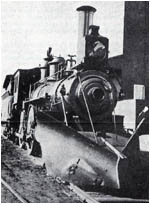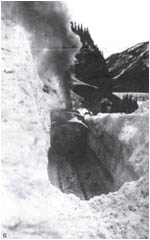Vol. 17 No. 3
March, 1987
|
Stay Safe in 87
|
|
Winters
Title Bout
"Business as Usual"
Saint John New Brunswick - Winter packed a title-bout
wallop across the Atlantic provinces this winter, but Maritimers are accustomed to digging out after
gale-force blizzards.
| |

An early form of pilot plow, introduced in the
1880s.
|
"Snow? What snow?", joked Saint John Division Superintendent Bud Andrews the morning after New Brunswick
was hit with one of the worst storms of the season. "As far as we're concerned, it's business as usual".
Business as usual means mobilizing crews and equipment on a moment's notice. Schools and businesses may close, power
may be out, highways may be shut down, and even the mail may not get through, but the railway still has to run.
"We're not going to let a little storm interfere with that," Mr. Andrews said.
Mr. Andrews knows his snow. He's served in some of the toughest snow-bound divisions, including
Schreiber as well as along the snow belt of central Ontario.
"Of course, the biggest battle is really faced by the crews between Calgary and Revelstoke. In Rogers Pass, the
annual snowfall averages around 1,000 centimetres, Added to that, you have the constant danger of huge
avalanches."
| |

First all-steel wing plow, built at Angus Shops
in 1909.
|
Mr. Andrews has a healthy respect for the crews who operate CP Rail's snow clearing equipment.
"We're not talking about sweeping off the front porch. Clearing the track after a major storm has always been
one of the railway's toughest jobs. When you look back over the years and see some of the photographs taken after
huge blizzards, you're left with a sense of awe. Nature is a pretty tough enemy at times," he said.
And nature did its level best as an adversary in January when a blizzard left more than 45 centimetres of snow in
its wake.
"We were ready for it, but I must admit we got dumped on a lot harder than expected. And it was a
one-two punch because we had one blizzard right on top of another".
CP Rail has been battling the annual snow wars for more than a century and, as a result, has become a world expert
in railway snow removal technology and techniques.
| |

An early form of flanger car, built at Hochelaga car shop in
east-end Montreal, was normally hooked onto the rear end of a freight train and used to clear
snow between rails. These were introduced in the 1880s.
|
"Let's face it, if you're going to run a railroad in Canada you have to be an expert in getting rid of
snow."
Snow removal equipment has come a long way since the CPR first pushed across Canada. The shovel, of course, hasn't
changed much, but the larger pieces of equipment have come in some rather strange and fanciful designs.
Gerry Brennan, manager of car projects with the mechanical department, has taken a special interest in the
evolution of CP Rail's snow removal equipment and has kindly provided CP Rail News with some rare photographs and
interesting technical data about the various pieces of equipment that have served loyally through the years.
"It's interesting to note that the development of snow removal equipment was largely due to Canadians and to
Canadian Pacific. The well-remembered rotary snow plow, for instance, was a development of an invention
of a compound revolving snow shovel, patented in 1869 by J.W. Elliot, a dentist from Toronto.
"His elementary device was modified by Orange Jull of Orangeville, Ontario. The Jull rotary was taken up by the
Leslie Brothers, also of Orangeville, who constructed a full-size model which was tried out in the
Parkdale yards of the CPR in 1884. The success of that trial led the Leslie Brothers to build a plow which was first
tested during the winter of 1886-87. It became the forerunner of the revolutionary rotaries long
remembered on the Prairie and Pacific Regions.
| |

Second generation Brothers snow melter was used in Western
Canada until the late 1950s.
|
Mr. Brennan's research shows that the first major piece of special snow clearing equipment used by the railway was
a push-plow built during the 1880s.
It was wedge-shaped and was mounted on the "A" end of a ballast car which, in turn, was
pushed ahead of a locomotive. It worked, but not very well. It seems that it spent almost as much time derailed as
it did pushing snow out of the way.
Pilot plows, which cold make better use of a locomotive's weight, replaced the push plows.
Although pilot plows varied in size and shape, they all were designed to use the front end of a locomotive for
support.
"In moderate snows without hard-packing or drifting, and where the rail line was free from deep
cuts, and train operation was fairly frequent, pilot plows did a reasonably good job," Mr. Brennan said.
The railway's first equipment acquired from an outside firm consisted of several self-contained units
from McMurray, Fuller & Co. of Toronto.
| |

One of two U.S.-built rotary plows purchased by
the railway in 1911.
|
The wooden "Fuller V-Shaped Plow weighed about 15 tonnes and was un-manned during
snow clearing operations.
"They did not always prove satisfactory. Often, particularly when the plow as pushing through deep drifts or
along rock cuts, the snow would fall back onto the track after the plow had passed."
The Russell "wing plow" design, which was a major improvement over the Fuller design, was first acquired
by the company in the mid-1890s. Square-nosed and constructed with strong timbers, the
wing plows were reinforced with structural steel.
A four-man crew operated the plow. The plow foreman, seated in a cupola, acted as lookout. He activated
the locomotive whistle by pulling an extension cord and used hand signals to communicate with the locomotive
engineer when plowing yards.
| |

Heavy rotary plow cuts through massive snow slide in the
Rockies during the early 1940s. Heavy rotary plows remained in service until the
mid-1950s.
|
The three helpers operated the wings and plow points. Three bells, each with a different tone, were attached to the
ceiling over the helpers' heads and were operated by pull cord from the cupola to signal right or left wing "in
or out" or plow point "up or down."
"The Russell plow had its shortcomings in that its manually-operated gear and lever mechanisms
that controlled the wings and point functioned too slowly to get plows over the road at maximum speed".
With the advent of locomotive air brakes, air pressure from the locomotives was used to power the plows' operating
mechanisms.
"The mechanical department, with experience gained from the operation and maintenance of the Russell plow,
designed and developed an air-operated plow in the car shop in Perth, Ontario. The first units were
built of wood on a metal underframe. All devices for the operation of the plow were located in a
two-man cupola."
The second series of company-built wing plows were made of steel.
"In fact, the CPR was the first railway to build and use an all-steel plow, the first of which,
came out of Angus Shops in 1909.
| |

One of two heavy rotary plows, built by Montreal Locomotive
Works about 1910. Both were used exclusively in Western Canada.
|
"The all-steel plow had a number of advantages, including greater strength and lower maintenance
cost. They also afforded greater protection to the crews."
Deep drifts and snow slides proved to be a major headache for snow clearing crews. The development of rotary plows
was a major step in making the job easier.
The rotaries could work their way through deep cuts and slides where it was impossible for wing plows to lift the
snow.
In 1888, the railway, in co-operation with the Polson Iron Works Company of Toronto, built eight of the
Leslie Brothers design rotaries in Montreal. The new rotaries were far superior to any earlier design. Without a
tender, they each weighed more than 56 tonnes.
| |

Barber-Greene snow melter CP
422025-26, assigned to the Montreal area, served until the late 1950s when diesel power replaced
steam.
|
The greatest test of the rotary snow plow was its ability to cut through snow slides. The rotary worked well under
normal circumstances, but wasn't much of a match against conditions in the Rocky, Selkirk, and Cascade Mountains.
Snow slides not only consisted of heavy, hard-packed snow, but often contained rocks and trees which
meant it was impossible to use the "light" rotaries.
"It was customary to probe the slide with sounding rods to locate debris and, if possible, it was removed by
blasting or by being pulled out. Sometimes, however, these obstacles were not discovered and when the rotary
encountered them, the ordinary cutting knives were often seriously damaged and the rotary often put out of
commission."
In 1909, Montreal Locomotive Works was given the task of building a new rotary plow that would stand up better to
buried debris.
| |

Conventional single-track wing plow using point
and wings to clear snow on the Saint John Division, shortly after New Brunswick was hit by a huge blizzard in
January 1987.
|
The result was a monster of a machine, equipped with five-centimetre-thick armor plate cutting knives
and an incredibly strong driving wheel made of cast steel weighing nearly 11 tonnes.
The new rotaries tipped the scales at almost 118 tonnes and were far superior to any other design.
The rotary plows - light and heavy - remained in service until the mid-1950s when they were replaced by
payloaders and bulldozers.
Today's railway snow plows burst through drifts and make quick work of what to the crews of yesteryear must have
seemed an almost impossible task.
This CP Rail News article is copyright
1987 by the Canadian Pacific Railway and is reprinted here with their
permission. All photographs, logos, and trademarks are the property of the Canadian Pacific Railway
Company.
|